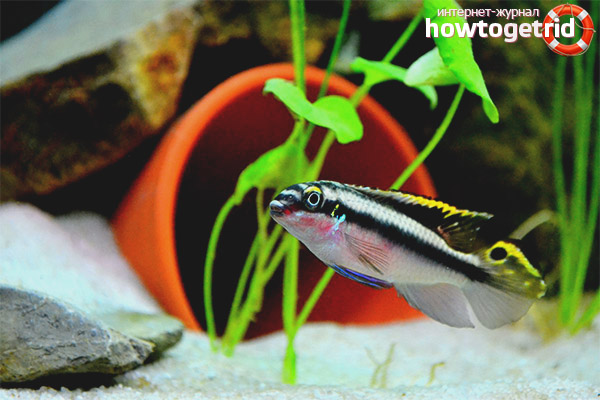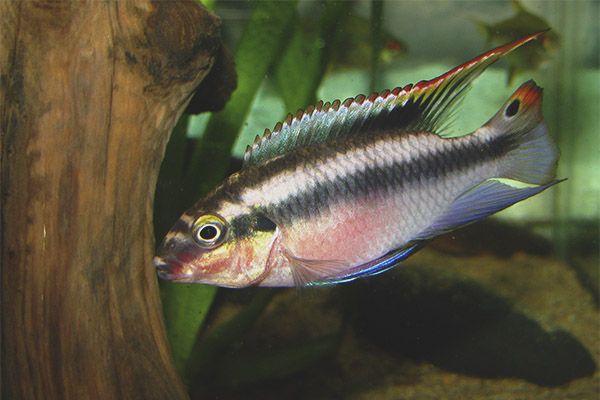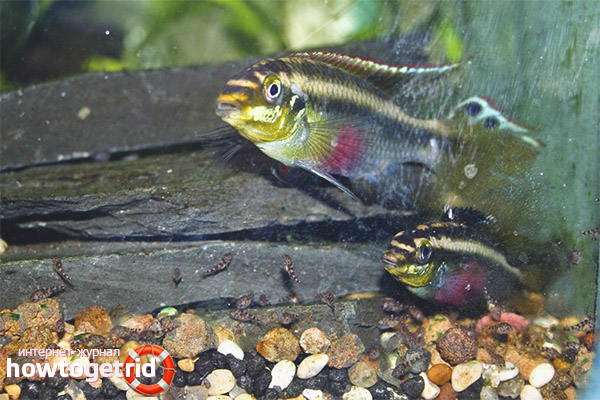The content of the article
Pelvicahromis Pulcher is a very small aquarium fish, but an unusual color with bright iridescent colors makes it stand out among its fellows. Due to the fun color, this fish is called "parrot". She has another name, not so difficult in pronunciation, - “kribensis”.
This species belongs to the family of cichlids, and it came to European aquarists from the Nigerian and Cameroon rivers, with obligatory dense vegetation on the bottom in combination with open spaces.
Pelvicahromis pulcher has a little body oblong, with multi-colored specks. Scales along crosses the dark line, the fins highlights the Kant.
Dimensions:
- In the female - up to 5 cm;
- In males - up to 8 cm. They also differ from females by the pointed ends of the spinal and anal fins.
On average, the period of their life is 5 years.
The life of "parrots" behind the glass
Those fish that are intended for sale are mostly bred under artificial conditions, because when they get into the aquarium for a permanent place of residence, they are already adapted to live in a container, and they take the limited space they are for granted. Only water should not be too hard, you need to follow a certain temperature regime - from 23 to 27 degrees Celsius. We also need aeration, filtration, experts suggest doing it through peat.
Choosing an aquarium for cribensis, you need to consider their number. If this is just a pair, then a 40-liter capacity is enough for her. But for the whole flock, the aquarium should reach 150 liters.
The bottom must necessarily be filled with various caves, grottoes, that is, shelters must be, then the pelvicahromis will be comfortable and cozy. There should be plants, preferably those that do not need bright light. By the way, their fish do not pull out of the ground, showing complete indifference to the greenery.
They prefer sand or gravel as soil.But there is a special requirement for gravel: its edges should not be sharp, as the fish often dig in it. They live not only in the lower layer, but also on average.
Pelvicahromis pulcher loves to frolic in the water, because to avoid trouble, the aquarium should be covered.
Must be at the bottom of snags, stones. And not only because then the conditions are more close to natural, but also for another reason. Each couple must have its own clearly delimited territory, and there must be several, for example, flower pots, in which the bottom should be removed.
The family guards this border, and if the owner of the aquarium miscalculated, and one couple was left without their own possessions, conflicts would be inevitable. A couple takes root in the pot when the male reaches 5 centimeters in length, and acquire their beautiful coloring. There are no fry yet, the territory is protected within a radius of 10 to 15 cm, and when the babies appear, the protection zone will increase.
Sometimes it happens that the parrot fish too rarely leave their homes, and if they do, they almost immediately frighten themselves. To help themIt is desirable to plant in the aquarium of small fish - mobile and unpretentious. For this perfect barbs.
When it's time to feed ...
The natural food of these fish is worms, insect larvae or invertebrates and small crustaceans. Because several times a week you need to give them live food. This may be daphnia and artemia. Live food is required to stimulate spawning.
Plant foods are also needed in the diet. This includes food from spirulina and even with cucumber. Fishes like industrial products - pills, granules, flakes.
During feeding, it is necessary to ensure that all the inhabitants have eaten, and not just those who are used to being in the upper layers. Pelvicahromis pulchera, which finds food at the bottom, should also get food.
Life with sharing
Kribensisy quite peaceful, but when it comes time to spawn, trying to protect the territory from encroachment, they become militant. To avoid slaughter, neighbors they need to pick up:
- preferring another layer of water;
- almost the same size;
- fast floating
It is worth paying attention to the Sword and Congo, danios and mollies. The most acceptable barbs are mossy and sumatran.
Most diseases can be prevented
Diseases in Pelvicahromis pulchera occur most often due to poor-quality care. First of all, this is dirty water, changes in its parameters that are not suitable for a pet. Poor food also provokes various diseases.
The most dangerous disease is hole-like disease, or, according to scientific terminology, hexamytosis. Its name is caused by the fact that a small depression appears on the head of the fish, and then a white deposit spreads. The younger generation is still too weak, because it quickly dies, and the adult often has a chronic form of the disease.
New generation - the road

Young fish are usually worn fun flock, but eventually find a partner. Moreover, loyalty retain pairs for life, and therefore it is not recommended to break them.
To push for spawning, you can artificially create conditions:
- raise the water temperature to 28 degrees;
- give live food.
During this period, the color of pelviquicrome pulchera becomes noticeably brighter in color. The female seduces the male with its graceful turns and bends, gradually pushing the future father into shelter. There will soon be up to 300 eggs that are attached to the walls. This place is now constantly under protection: the female is near the eggs, the head of the family serves at the entrance. This period lasts up to 6 days.
Then the larvae, leaving the shell of eggs, showered at the bottom of the shelter. There they will spend from 4 to 6 days.
During this period, such difficulties may arise:
- The couple start a quarrel. So, you need to otsadit those who are offended.
- Parents eat eggs. Caviar itself is taken into a separate container, providing aeration and filtration there.
Feed the young simply. This is mainly living dust, and a week after hatching - Artemia. You can give them pounded flakes, but they must be of high quality. Kids grow fast.Up to 4 months, their color is just a small dark speck. Gradually, month after month, stripes appear on a light background. But then there are the usual bright colors, as well as all the habits inherent in adult fish. Usually they grow together, and almost never have to produce sorting.
If there is an interest in more intensive dilution, the eggs placed in the pot are sent to the incubator, providing a sprayer next to it. The first feeding will be after the fry swam. With this method, parents will lay eggs more often.
Video: aquarium fish pelvicahromis pulcher












To send